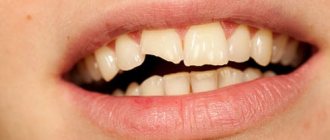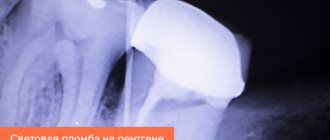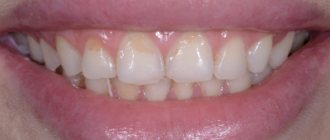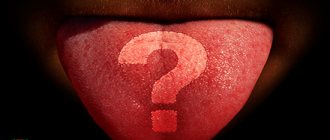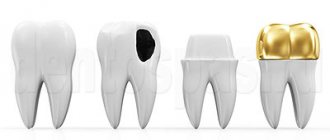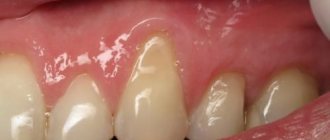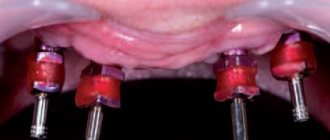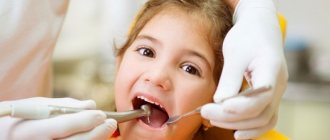Teeth crumble in both older people, small children, and even young people. No one is immune from this problem. Because of this pathology, people have difficulty eating, their smile deteriorates, pain occurs, and in the most extreme cases, it even leads to tooth loss.
Tooth decay is irreversible and increases in mathematical progression. Therefore, for example, if you delay tooth restoration for only 1-2 weeks, you significantly increase your dentist costs.
Why do teeth decay?
The enamel becomes thinner due to dental pathology or diseases not related to the oral cavity. Most often, adults' teeth crumble due to advanced caries. Through the carious “hollow”, microbes penetrate into the deep layers of enamel and damage it from the inside. And then the enamel breaks off when chewing if a small area of healthy tissue remains between the carious cavity and the outer layer.
Non-carious lesions include erosion - a surface defect of dental tissues. There are the following causes of erosion:
- Mechanical injury . Develops due to hard food, very hard brushes, abrasive toothpaste or ultrasonic professional cleaning.
- Chemical damage . Appears if you eat a lot of acidic foods. The acidic environment disrupts the absorption of minerals, and they are washed out of the enamel. Chemical bleaching is another cause of erosion.
- Reflux esophagitis . When sick, the acidic contents of the stomach are thrown back into the esophagus, reaches the oral cavity and affects the acid-base balance.
- Nutrient deficiency . When little calcium, magnesium, phosphorus and fluorine come from food, the enamel does not receive the necessary microelements, and its density decreases.
- Digestive disorders . If the stomach or intestines lack enzymes or the mucous membrane is inflamed, beneficial substances are not absorbed into the blood.
- Hormonal disorders . With an excess or deficiency of hormones, calcium is washed out of dental tissues faster.
- Incorrect bite . When tooth surfaces do not contact properly, the enamel layer is worn away.
- Bruxism . If the jaw muscles become overly tense at night, teeth grinding occurs. Due to constant friction, their chewing surface wears off.
- Fluorosis . If there is an excess of fluoride in food, drinking water, or taking fluoride-containing medications, the mineralization of enamel is disrupted.
In children, the front “milk jugs” easily crumble due to the habit of sucking a bottle or pacifier. Because of this, the bite changes and caries develops faster.
Both baby and permanent teeth crumble easily if there is a hereditary predisposition. It is manifested by increased abrasion of the enamel or its underdevelopment - hypoplasia.
Hypoplasia of the “milk jugs” develops even before birth if pregnancy occurs with complications. Hypoplasia of permanent teeth is associated with metabolic disorders, so it occurs more often in pregnant women, in adolescents during puberty and in women during menopause.
When does a tooth crumble without pain?
The tooth decays and hurts due to deep erosion or caries. With chips, as a rule, there is no pain, since the dentin and pulp are not damaged. If a significant portion of the crown is chipped, the patient may not feel pain, but due to dentin exposure, sensitivity to hot, sour or sweet foods increases. There may also be no pain if the pulp is completely destroyed.
Recommendations for pregnant women and children
Teeth crumble during pregnancy
Pregnancy is accompanied not only by hormonal changes in the body, but also by changes in metabolic processes. The child takes nutrients from the mother, including calcium, which is so necessary for teeth. Therefore, it is very important that the expectant mother receives a double dose of vitamins and minerals with her diet, which will be enough for both her and the baby.
Child's tooth crumbled
Children's teeth crumble quite often. The most common causes are a lack of vitamins and minerals, as well as injuries. In order for a child’s baby teeth to be healthy, it is necessary to provide him with adequate nutrition and strong immunity. You can choose dental treatment for children in private and public clinics.
How to prevent tooth decay?
To choose treatment tactics, the dentist conducts an examination and prescribes tests. Small defects are identified using vital staining: if there is a chip or erosion, dye accumulates in them.
At the first signs of enamel destruction, the doctor carries out:
- Treatment of inflammation of the oral cavity . Eliminates inflammation to restore acid-base balance. In an alkaline environment, bacteria destroy the enamel layer more slowly.
- Remotherapy . Makes applications with a solution containing microelements that strengthen the enamel from the inside.
- Fluoridation . Coats the enamel with fluoride varnish to slow down the leaching of calcium. The procedure is contraindicated for fluorosis.
- Cleaning the carious cavity . To save the tooth, it removes destroyed tissue and bacteria from the crown.
If teeth are crumbling due to chronic diseases of internal organs, consultation with specialists is required. The dentist will recommend being examined by a therapist, who will refer you to the right doctor.
Poor nutrition
Proper nutrition affects both the entire body as a whole and its individual systems, including preventing the development of dental diseases. The most dangerous is the unreasonable consumption of carbohydrates, namely sugar-containing products, and their significant predominance in the diet.
To maintain dental health, it is recommended to include foods rich in:
- protein (meat, fish, eggs, milk), since its deficiency has an unsatisfactory effect on the accumulation of calcium;
- fluoride (seafood, fish, buckwheat, radishes, carrots), the optimal amount of which increases the resistance of tooth enamel to pathological factors;
- calcium (cabbage, nuts, fruits, dairy products), which has a positive effect on the crystal lattice of teeth.
In order to avoid negative effects on the jaw system, you should limit the consumption of sticky, viscous foods - toffee, chocolate bars, liquid caramel.
Such food sticks to the teeth, is poorly washed off by saliva, and contributes to the development of caries. You should not abuse sweet carbonated drinks and packaged juices, due to the high sugar content in them.
How are damaged teeth restored?
The dentist eliminates a tooth defect using fillings, artistic restoration or microprostheses - artificial crowns, veneers, inlays and lumineers.
The choice of restoration method depends on the location of the tooth and the size of the defect:
- Chips on back teeth . To cover them, the crown is filled or inlays are installed - large fillings made of ceramics or metal-ceramics. The filling or inlay will not be noticeable on molars and premolars.
- Chips in the smile area . If the front teeth crumble, the doctor performs artistic restoration. He replaces the defect with a composite material so that the enamel looks natural.
- Chips on milk jugs . Temporary teeth are restored with a filling or artistic restoration. Pediatric dentists try to preserve the ducts so that the child’s bite develops correctly.
- Significant destruction of the crown . The dentist covers large defects with an artificial crown. If the tooth is destroyed to the root, a pin is placed, onto which a filling or crown made of ceramic, metal or zirconium is then attached. When it is impossible to save even the root, the only restoration method is a bridge or implantation.
It is better to install microprostheses in the smile area. Small chips, scratches or cracks on the front surface of the enamel are masked with veneers or lumineers. If the enamel is thin, wears off quickly, or is sensitive to cold, a specialist will recommend a crown made of ceramic or zirconium.
Bad habits
If one side of health is insufficient protection from negative factors, then the other is harm from one’s own lifestyle. Thus, the condition of the teeth of smokers is almost always criticized: yellow, stained, with problem areas, with unhealthy gums. The more a person smokes, the more problems he has with his teeth. Not to mention bad breath.
The fact is that cigarette smoke causes the formation of dark spots on the enamel, which are difficult to get rid of. In addition, tobacco negatively affects blood circulation in the gums. This, by the way, can cause the development of periodontal disease and other gum diseases.
Prevention of tooth decay
To keep your teeth healthy, you need to keep them clean and treat chronic diseases in a timely manner. Dentists recommend adhering to the following rules:
- Use toothpaste with a high content of calcium and fluoride;
- Brush your teeth with a soft brush;
- Clean your tongue thoroughly, as bacteria that cause caries accumulate on it;
- After eating, floss and rinse your mouth with an herbal solution;
- Do not chew hard objects;
- Do not introduce your baby to pacifiers or bottles;
- Take food no later than 3 hours before bedtime, so that in a horizontal position it does not fall back into the esophagus and then into the mouth;
- Add vegetables and fruits to your diet to saturate your body with vitamins and microelements;
- Limit sweet and sour foods that disrupt the acid-base balance in the mouth;
- Eat food warm, do not add ice to drinks;
- Give up bad habits - smoking and alcohol abuse.
In order to notice the first signs of enamel damage in time and remove plaque that causes caries, you need to visit the dentist twice a year and carry out professional hygiene.
What to do?
As soon as you notice that your tooth has crumbled, make an appointment with the dentist immediately. If you managed to collect the broken pieces, you need to take them to the dentist and show them.
If pain occurs, it is recommended to leave the damaged area alone (chew on the other side and do not touch it with your tongue) and take an analgesic (Ketanov, Nimesulide, Nurofen, etc.).
In case of severe damage, it is advisable to exclude very hot and very cold foods and drinks, which can provoke a painful reaction when the neurovascular tissue is exposed.
Useful sections
In these sections you will find more information about why teeth crumble and decay:
- Dental treatment
- Restoration of the tooth crown
- Microprosthetics
Bibliography:
- Mikaelyan N.P., Komarov O.S. “Biochemistry of hard tissues of the oral cavity in normal and pathological conditions. Training manual" - 2019
- Salova A.V. “Features of aesthetic restoration in dentistry. Practical guide" - 2008
Author of the article: Mariam Arutyunovna Harutyunyan
Copywriter of the information portal Stom-Firms.ru. Specialization in translations and original articles on medicine and dentistry.
Diagnostic measures
Finding out why teeth crumble in an adult or a child, and what to do to preserve the enamel, can only be done in dentistry. The doctor examines the oral cavity, assesses the nature of the damage, collects information about the patient’s general condition and existing chronic diseases. For accurate diagnosis the following methods can be used:
- Blood test - general and biochemistry.
- Blood test for hormone levels.
- Allergy tests.
- X-ray of the jaw.
If, while searching for an answer to the question of why teeth are decaying in an adult patient, the dentist suspects an internal disease, he will send the patient for a consultation with an appropriate specialist: an endocrinologist, immunologist, therapist, nutritionist.
Malocclusion
Malocclusion is diagnosed in the majority of the population. But, people go to the clinic for its correction only in case of a pronounced anomaly, although due to malocclusion the following occurs:
- Uneven load on teeth when chewing food. For some of them it is double the amount, while others are inactive. Due to excessive pressure, dental tissue is destroyed, leading to tooth loss.
- Reduced chewing activity, since not every tooth can participate in the process. To chew food well, you need to close your jaws tightly, but if you want to do this, discomfort and pain often occur. As a result, the composition of bone and soft tissue is disrupted.
An incorrect bite provokes the occurrence of an inflammatory process in the gums - periodontitis. In some people, due to an abnormal bite, involuntary grinding of teeth occurs - bruxism, which causes tooth wear and loosening.
Improper hygiene
To maintain dental health, daily oral hygiene is necessary. The main thing that is taught from early childhood is to clean them twice a day, morning and evening, preferably after eating for at least 3 minutes.
In addition, proper hygiene includes:
- optimal selection of toothbrush and toothpaste, depending on the condition of the gums and teeth;
- replacing the old brush with a new one at least once every three months;
- cleansing the tongue and cheeks.
People who maintain proper hygiene are less likely to develop gingivitis and periodontal disease.
In addition to a toothbrush and paste, it is recommended to use special rinses and floss, the diameter of which is selected depending on the distance between the teeth, to clean the oral cavity. You should not use one paste for more than 3 months to avoid addiction.

